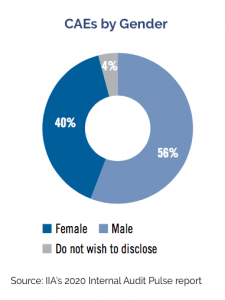
According to a new internal audit survey report, the percentage of women in internal audit leadership roles increased significantly over the last three years. A study of internal auditors found that 40 percent of chief audit executive respondents identified themselves as female, up from 33 percent of chief auditors who did in 2017.
The 2020 North American Pulse of Internal Audit report, released this week by the Institute of Internal Auditors, found that the percentage of women in internal audit leadership roles is up at nearly all types of organizations. In fact, at public sector organizations, such as public universities and municipalities, the percentage of women in chief audit executive (CAE) jobs surpassed men, rising from 43 percent in 2017 to 52 percent today. While publicly traded companies saw the biggest gains over the past four years, this group still lags behind other organization types, with women accounting for only about one-third of survey respondents (32 percent).
 “What these demographic changes will mean to the profession remains to be seen, but studies identify positive impacts of gender diversity, and leaders who built their careers in the digital era may be more likely to adapt readily to technological change,” the report’s authors wrote.
“What these demographic changes will mean to the profession remains to be seen, but studies identify positive impacts of gender diversity, and leaders who built their careers in the digital era may be more likely to adapt readily to technological change,” the report’s authors wrote.
Women have also made gains in internal audit leadership roles at financial services companies. The percentage of CAEs who identify themselves as female increased from 39 percent in 2017 to 42 percent today, according to the Pulse report. At privately held companies, the percentage increased four points to 34 percent over the same time frame.
Gender Diversity Benefits
Some research has supported the idea that gender diversity in professional leadership roles brings many benefits to organizations. “One of two studies featured in the Harvard Business Review showed gender diversity leads to higher productivity in areas where diversity is ‘normatively’ accepted,” the Pulse report stated. “The other study found women do better in 84 percent of the leadership competencies it measured, including taking initiative, acting with resilience, practicing self-development, driving for results, and displaying high integrity and honesty.”
The Pulse report also identified a generational shift among internal audit leadership positions. More than half of CAEs say they are from Generation X (39 to 54 years old), while another 10 percent are Millennials (age 23 to 38). Baby Boomers (age 55 to 73) now make up just 36 percent of CAE positions. “This generational shift
is likely related to the natural cycling
of these generations into leadership positions as some members of the Baby Boom generation reach retirement age,” the report states. ![]()

